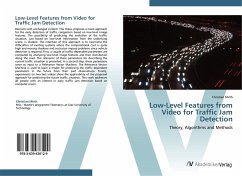
Low-Level Features from Video for Traffic Jam Detection
Theory, Algorithms and Methods
Versandkostenfrei!
Versandfertig in 1-2 Wochen
32,99 €
inkl. MwSt.

PAYBACK Punkte
16 °P sammeln!
Revision with unchanged content. This thesis proposes a novel approach for the early detection of traffic congestion based on low-level image features. The possibility of predicting the evolution of the traffic situation, just based on low-level information from the underlying scene, is studied. The intention of this approach is to overcome the difficulties of existing systems where the computational cost is quite high and moving shadows and occlusion impose problems since vehicle detection is required. First, a couple of traffic-dependent parameters are computed by analyzing low-level image f...
Revision with unchanged content. This thesis proposes a novel approach for the early detection of traffic congestion based on low-level image features. The possibility of predicting the evolution of the traffic situation, just based on low-level information from the underlying scene, is studied. The intention of this approach is to overcome the difficulties of existing systems where the computational cost is quite high and moving shadows and occlusion impose problems since vehicle detection is required. First, a couple of traffic-dependent parameters are computed by analyzing low-level image features and their distribution along the road. The relevance of these parameters for describing the current traffic situation is presented. In a second step, these parameters serve as input to a Relevance Vector Machine. The Relevance Vector Machine is used to learn a model for predicting the traffic-dependent parameters in the future from their past observations. Finally, experiments on twotest videos show the applicability of the proposed approach for predicting the future traffic situation. This work addresses all people with an interest in early traffic jam detection based on computer vision.












